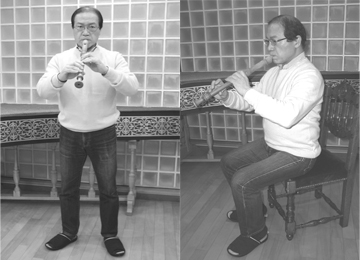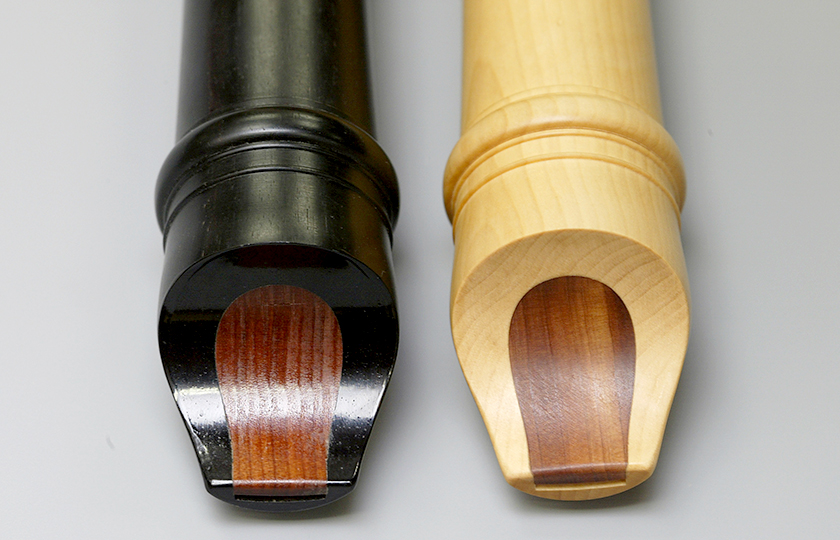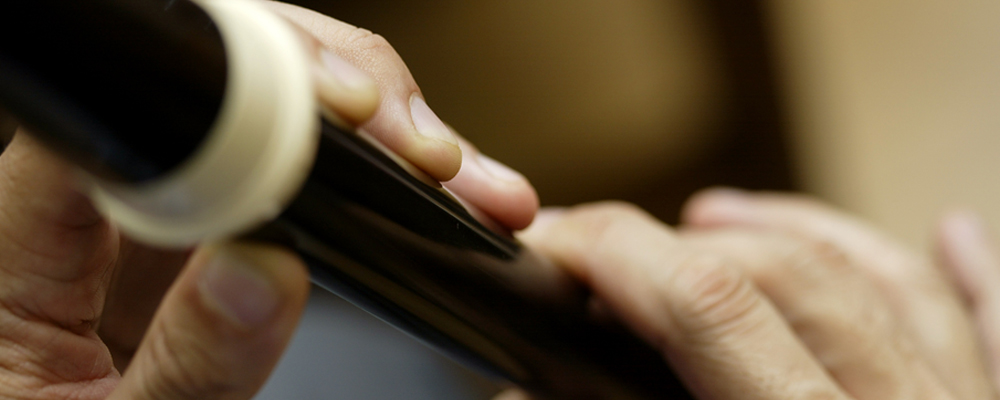How to Play the Recorder
Familiar but challenging recorder performances
Easy to produce high-pitched tones
The block of the recorder makes it easy for anyone to produce sound using the instrument.
Also, in general, whistles produce a lower pitch sound as more of their tone holes are covered using the fingers. However, just by covered the tone hole on the underside of the recorder very slightly, sounds one, two or three octaves higher can be produced irrespective of how many of the other tone holes are covered.
Furthermore, if the finger is shifted while playing and the tone hole is gradually opened, the sound will gradually change by one full tone.
This technique is known as "glissando" or "portamento," and is often used in contemporary works for the recorder.

How to hold the instrument correctly
In a position where one can breathe comfortably, and considering the whole body as a resonator, support the instrument while maintaining the posture you might visualize if imagining a circle that touches the sternoclavicular joint, the shoulder, the elbow, the wrist, and the fingers.
When performing while standing, open the legs slightly and shift a little weight onto the toes. When performing while seated, sit shallowly in the chair with feet firmly planted on the floor.
Support the instrument well by balancing it between your lower lip, the thumb of your right hand, and the middle finger of your left hand. Particular care should be taken with the position of the right thumb. A good position is perhaps behind that of the right middle finger, by just a little or slightly more.
Because the shape and length of fingers vary from person to person, it is best to find the position for the right thumb that suits you best. In particular, many beginners place their right thumb too high on the instrument, so it is good to exercise caution.

Left: Holding the instrument while standing Right: Holding the instrument while seated Model: Minoru Yoshizawa (recorder player)
Breathing tips
Visualize releasing the breath steadily.
If breathing slowly through the nose, it is understood that breath enters not only the front of the chest but also both sides of the back. When inhaling breath through the mouth normally, it enters the same locations.
When producing sound with a recorder, beginners tend to inhale too much air. While feeling the resistance from the instrument and the pressure rebounding from it, it's best to try and breathe steadily, taking in a moderate volume of air. Aim for a breathing technique that is controlled, as though singing vocals for a song.
When covering the tone holes
It's not necessary to press the finger onto the tone hole with excessive force. Those with large hands or long fingers can cover the holes with the second section of the finger, and it's recommended for each individual to find a playing style that is comfortable and easy for them.
Two reasons sound may not be produced
When sound is not produced, check whether enough air is being blown into the recorder, or if the breath is being blown into the instrument with too much force.
First, while playing, have another person take a look to see if you are covering the tone holes correctly. Sometimes there are problems such as inadvertently moving the ring finger along with the little finger of the right hand when pressing on the holes, which is difficult to notice by oneself.
When blowing the instrument too forcefully, sometimes there is a high-pitched, beep-like sound. This sound is the harmonic, one octave higher than the intended note, produced because the sound is being forced to rebound onto itself. The problem can be solved by blowing more gently. It is important to control the breath.
Checking the block is not too moist
In a wooden recorder, red cedar is used for the block. This is high-grade, eastern red cedar (Juniperus virginiana), and is the same material used for the decks of boats because it is less susceptible to rot. Recently it has been used to produce sweet-smelling, circular-shaped insect repellent.
Red cedar mellows the sound, but if played for a long period it can become saturated with moisture (to the extent that it is unable to absorb any more), and the quality of sound produced deteriorates. This is the reason the sound quality becomes poor if the instrument is played for many hours in one day. Water droplets also accumulate in the grooves, so it's best to remove moisture diligently.

Recorders made from ebony, left, and Japanese boxwood (Buxus microphylla var. japonica), right. The blocks in both recorders are made from red cedar
Enjoying playing in a recorder ensemble, as a hobby
The most popular recorder performances are, as one might expect, those by ensembles. In particular, quartets featuring soprano, alto, tenor and bass are most frequently seen. When playing in an ensemble, even though the song is the same, the degree of difficulty varies according to the part being performed. For beginners, how about choosing a simpler part and giving it a try? By playing in an ensemble alongside those with more developed skills, it's possible to improve one's own level of skill and enjoy performances a great deal.

